snow chains MINI Paceman 2016 Owner's Manual (Mini Connected)
[x] Cancel search | Manufacturer: MINI, Model Year: 2016, Model line: Paceman, Model: MINI Paceman 2016Pages: 223, PDF Size: 5.52 MB
Page 77 of 223
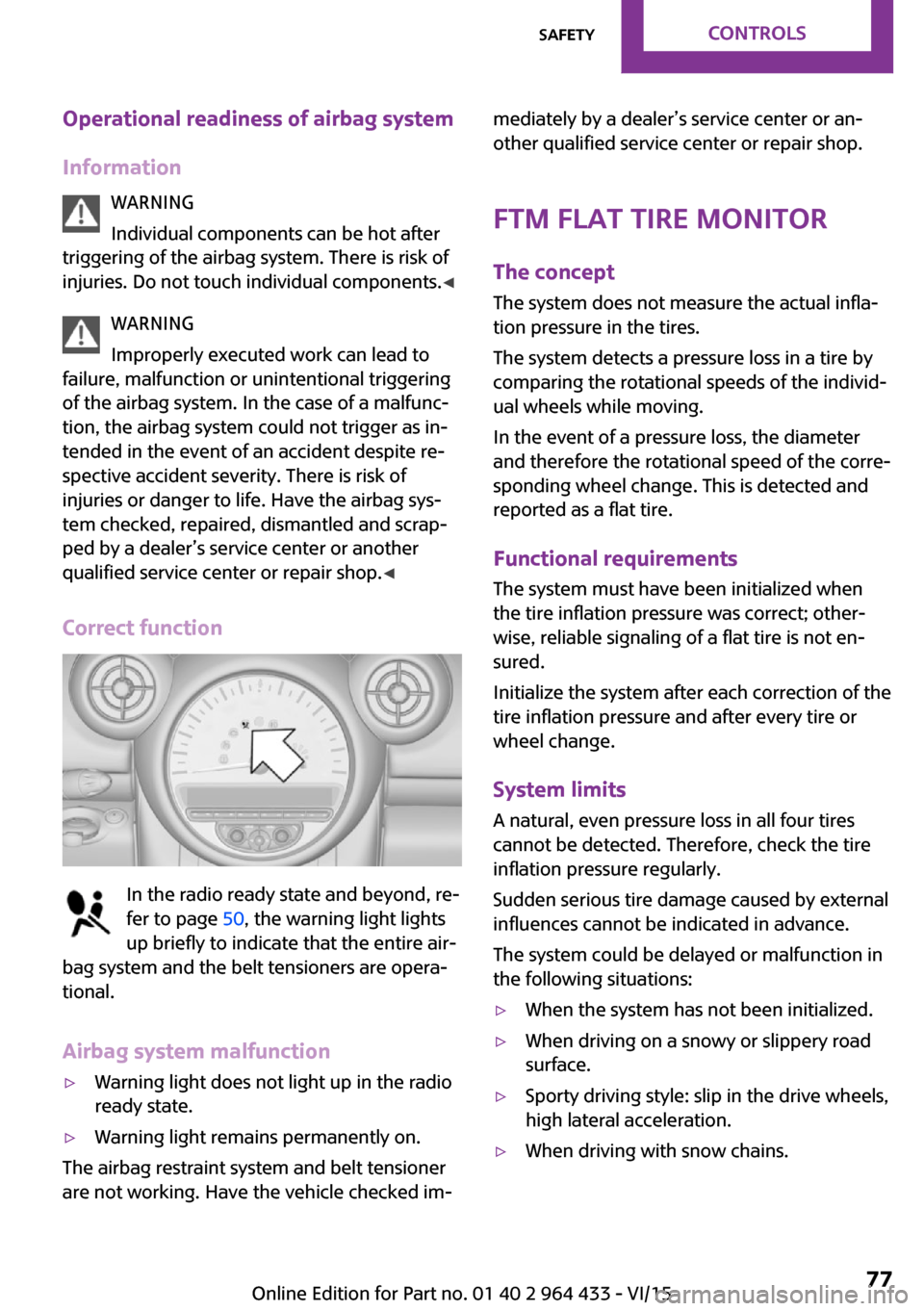
Operational readiness of airbag system
Information WARNING
Individual components can be hot after
triggering of the airbag system. There is risk of
injuries. Do not touch individual components. ◀
WARNING
Improperly executed work can lead to
failure, malfunction or unintentional triggering of the airbag system. In the case of a malfunc‐
tion, the airbag system could not trigger as in‐ tended in the event of an accident despite re‐
spective accident severity. There is risk of
injuries or danger to life. Have the airbag sys‐
tem checked, repaired, dismantled and scrap‐
ped by a dealer’s service center or another
qualified service center or repair shop. ◀
Correct function
In the radio ready state and beyond, re‐
fer to page 50, the warning light lights
up briefly to indicate that the entire air‐
bag system and the belt tensioners are opera‐
tional.
Airbag system malfunction
▷Warning light does not light up in the radio
ready state.▷Warning light remains permanently on.
The airbag restraint system and belt tensioner
are not working. Have the vehicle checked im‐
mediately by a dealer’s service center or an‐
other qualified service center or repair shop.
FTM Flat Tire Monitor
The concept
The system does not measure the actual infla‐
tion pressure in the tires.
The system detects a pressure loss in a tire by
comparing the rotational speeds of the individ‐
ual wheels while moving.
In the event of a pressure loss, the diameter
and therefore the rotational speed of the corre‐
sponding wheel change. This is detected and
reported as a flat tire.
Functional requirements
The system must have been initialized when
the tire inflation pressure was correct; other‐ wise, reliable signaling of a flat tire is not en‐
sured.
Initialize the system after each correction of the
tire inflation pressure and after every tire or
wheel change.
System limits
A natural, even pressure loss in all four tires
cannot be detected. Therefore, check the tire
inflation pressure regularly.
Sudden serious tire damage caused by external
influences cannot be indicated in advance.
The system could be delayed or malfunction in
the following situations:▷When the system has not been initialized.▷When driving on a snowy or slippery road
surface.▷Sporty driving style: slip in the drive wheels,
high lateral acceleration.▷When driving with snow chains.Seite 77SafetyCONTROLS77
Online Edition for Part no. 01 40 2 964 433 - VI/15
Page 78 of 223
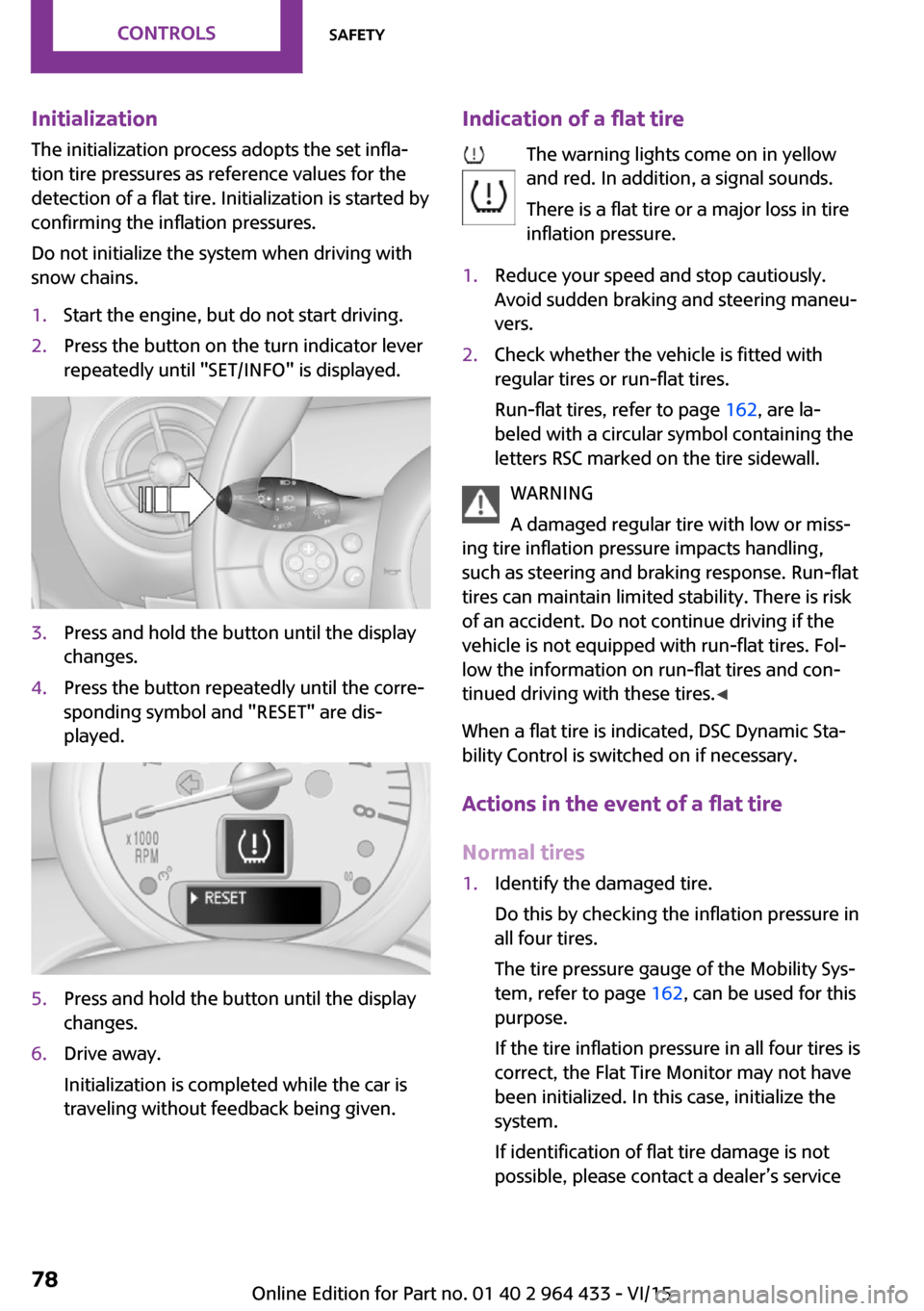
InitializationThe initialization process adopts the set infla‐
tion tire pressures as reference values for the
detection of a flat tire. Initialization is started by
confirming the inflation pressures.
Do not initialize the system when driving with
snow chains.1.Start the engine, but do not start driving.2.Press the button on the turn indicator lever
repeatedly until "SET/INFO" is displayed.3.Press and hold the button until the display
changes.4.Press the button repeatedly until the corre‐
sponding symbol and "RESET" are dis‐
played.5.Press and hold the button until the display
changes.6.Drive away.
Initialization is completed while the car is
traveling without feedback being given.Indication of a flat tire
The warning lights come on in yellow
and red. In addition, a signal sounds.
There is a flat tire or a major loss in tire
inflation pressure.1.Reduce your speed and stop cautiously.
Avoid sudden braking and steering maneu‐
vers.2.Check whether the vehicle is fitted with
regular tires or run-flat tires.
Run-flat tires, refer to page 162, are la‐
beled with a circular symbol containing the
letters RSC marked on the tire sidewall.
WARNING
A damaged regular tire with low or miss‐
ing tire inflation pressure impacts handling,
such as steering and braking response. Run-flat
tires can maintain limited stability. There is risk
of an accident. Do not continue driving if the
vehicle is not equipped with run-flat tires. Fol‐
low the information on run-flat tires and con‐
tinued driving with these tires. ◀
When a flat tire is indicated, DSC Dynamic Sta‐
bility Control is switched on if necessary.
Actions in the event of a flat tire
Normal tires
1.Identify the damaged tire.
Do this by checking the inflation pressure in
all four tires.
The tire pressure gauge of the Mobility Sys‐
tem, refer to page 162, can be used for this
purpose.
If the tire inflation pressure in all four tires is
correct, the Flat Tire Monitor may not have
been initialized. In this case, initialize the
system.
If identification of flat tire damage is not
possible, please contact a dealer’s serviceSeite 78CONTROLSSafety78
Online Edition for Part no. 01 40 2 964 433 - VI/15
Page 85 of 223

Deactivating DSC
Press the switch until the DSC OFF indicator
lamp lights up in the speedometer and DSC OFF
appears in the tachometer. DSC is deactivated.
Intervening measures to stabilize the vehicle
and give it forward momentum are no longer
executed.
When driving with snow chains or to rock the
vehicle free of snow, it may be useful to deacti‐
vate DSC temporarily.
To increase vehicle stability, activate DSC again
as soon as possible.
Activating DSC
Press the switch again; the DSC indicator lamps
in the display elements go out.
Indicator/warning lights The indicator lamp in the tachometer
flashes: DSC is controlling the drive
forces and brake forces.
The indicator lamp lights up: DSC and DTC has
failed.
The indicator lamp in the speedometer
lights up and DSC OFF appears in the
tachometer.
DSC and DTC deactivated.
Dynamic Traction Con‐
trol DTC
The concept
The DTC system is a version of the DSC in which
forward momentum is optimized.
The system ensures maximum forward mo‐
mentum on special road conditions, e.g., unp‐
lowed snowy roads, but driving stability is lim‐
ited.
It is therefore necessary to drive with appropri‐
ate caution.
You may find it useful to briefly activate DTC
under the following special circumstances:
▷When driving in sand, on snowy inclines, in
slush, or on unplowed, snow-covered road
surfaces.▷When rocking a vehicle free or starting off
in deep snow, sand, or on loose ground.▷When driving with snow chains.Seite 85Driving stability control systemsCONTROLS85
Online Edition for Part no. 01 40 2 964 433 - VI/15
Page 165 of 223
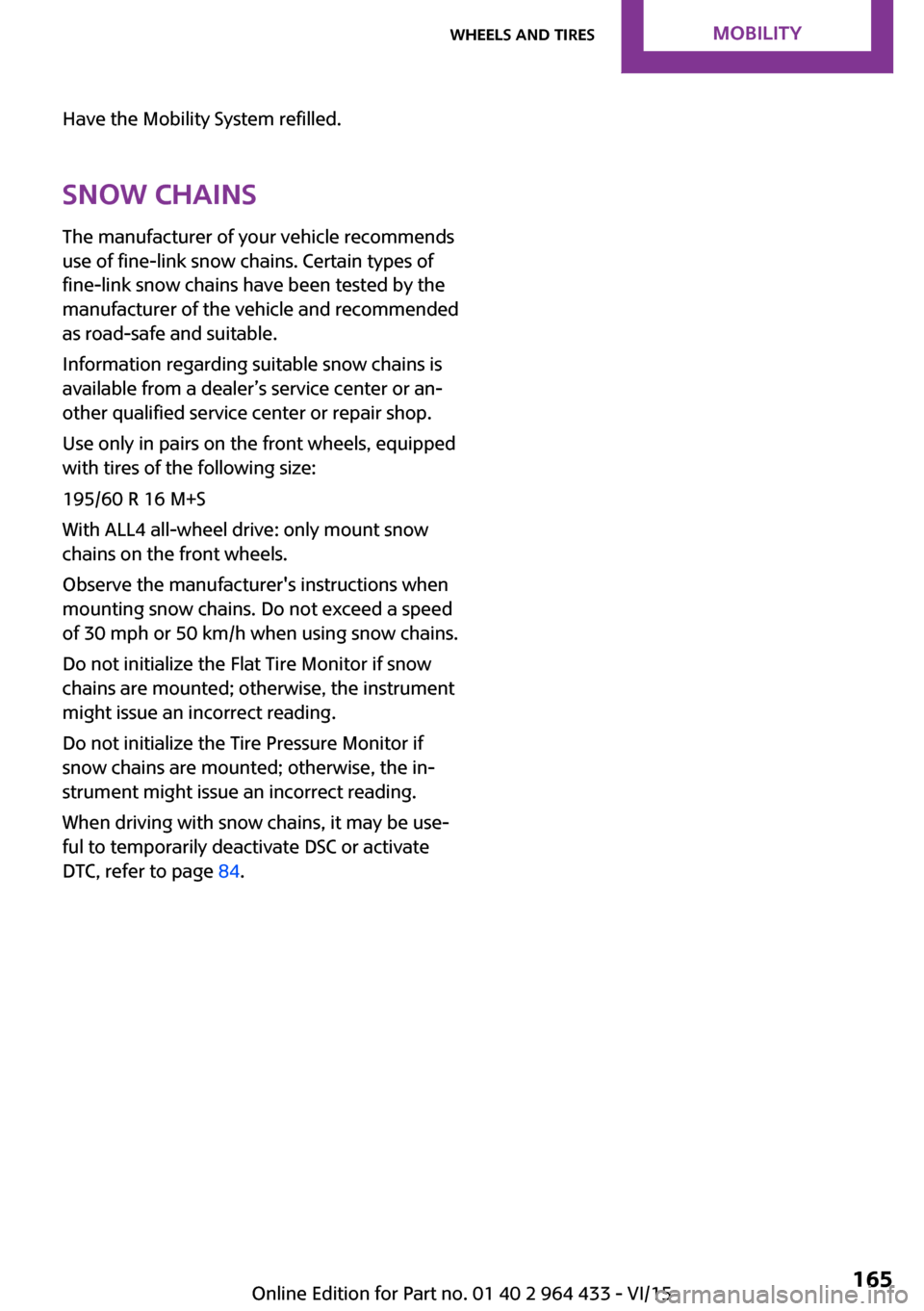
Have the Mobility System refilled.
Snow chains The manufacturer of your vehicle recommends
use of fine-link snow chains. Certain types of
fine-link snow chains have been tested by the
manufacturer of the vehicle and recommended
as road-safe and suitable.
Information regarding suitable snow chains is
available from a dealer’s service center or an‐
other qualified service center or repair shop.
Use only in pairs on the front wheels, equipped
with tires of the following size:
195/60 R 16 M+S
With ALL4 all-wheel drive: only mount snow
chains on the front wheels.
Observe the manufacturer's instructions when
mounting snow chains. Do not exceed a speed
of 30 mph or 50 km/h when using snow chains.
Do not initialize the Flat Tire Monitor if snow
chains are mounted; otherwise, the instrument
might issue an incorrect reading.
Do not initialize the Tire Pressure Monitor if
snow chains are mounted; otherwise, the in‐
strument might issue an incorrect reading.
When driving with snow chains, it may be use‐
ful to temporarily deactivate DSC or activate
DTC, refer to page 84.Seite 165Wheels and tiresMOBILITY165
Online Edition for Part no. 01 40 2 964 433 - VI/15
Page 215 of 223
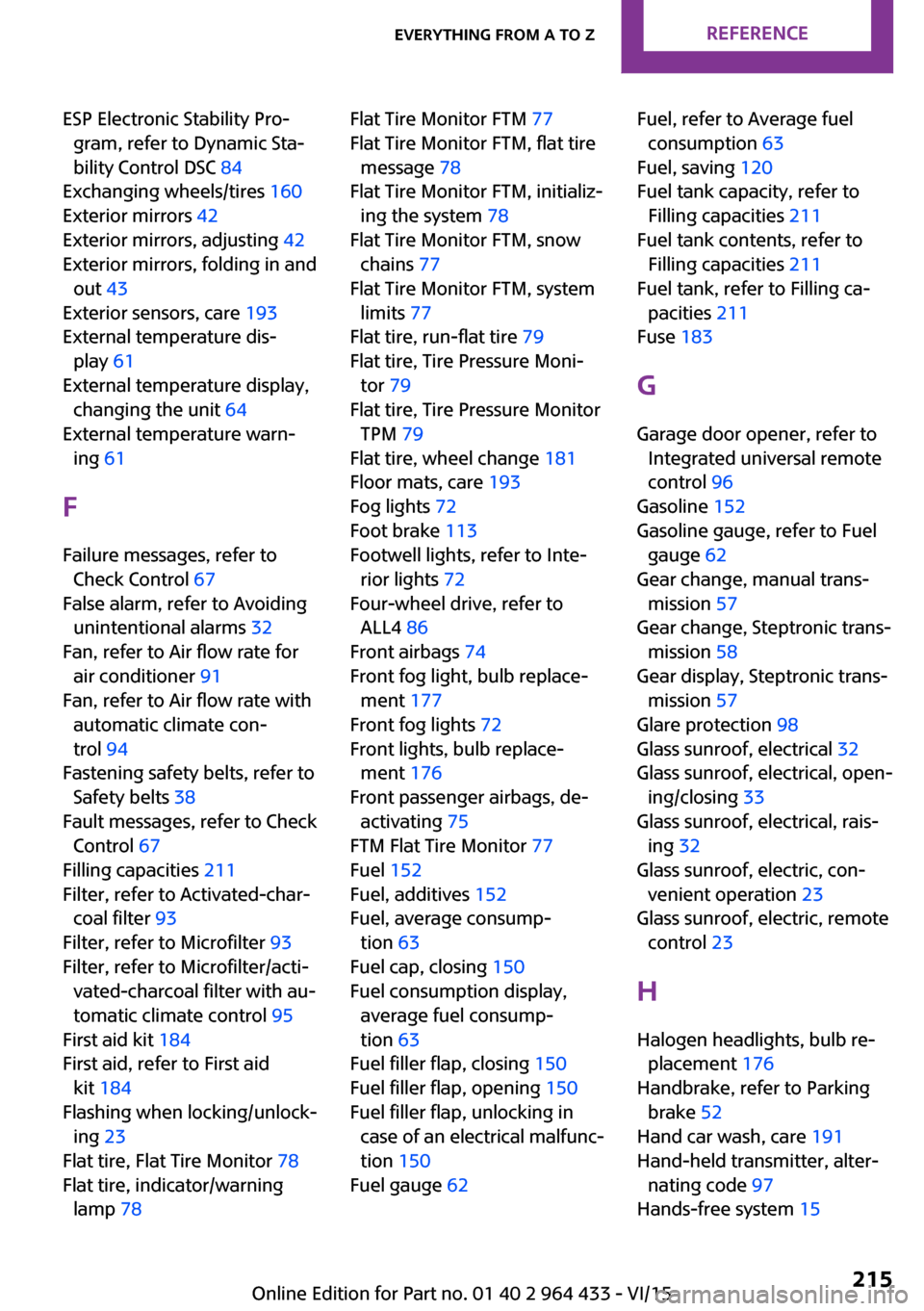
ESP Electronic Stability Pro‐gram, refer to Dynamic Sta‐
bility Control DSC 84
Exchanging wheels/tires 160
Exterior mirrors 42
Exterior mirrors, adjusting 42
Exterior mirrors, folding in and out 43
Exterior sensors, care 193
External temperature dis‐ play 61
External temperature display, changing the unit 64
External temperature warn‐ ing 61
F Failure messages, refer to Check Control 67
False alarm, refer to Avoiding unintentional alarms 32
Fan, refer to Air flow rate for air conditioner 91
Fan, refer to Air flow rate with automatic climate con‐
trol 94
Fastening safety belts, refer to Safety belts 38
Fault messages, refer to Check Control 67
Filling capacities 211
Filter, refer to Activated-char‐ coal filter 93
Filter, refer to Microfilter 93
Filter, refer to Microfilter/acti‐ vated-charcoal filter with au‐
tomatic climate control 95
First aid kit 184
First aid, refer to First aid kit 184
Flashing when locking/unlock‐ ing 23
Flat tire, Flat Tire Monitor 78
Flat tire, indicator/warning lamp 78 Flat Tire Monitor FTM 77
Flat Tire Monitor FTM, flat tire message 78
Flat Tire Monitor FTM, initializ‐ ing the system 78
Flat Tire Monitor FTM, snow chains 77
Flat Tire Monitor FTM, system limits 77
Flat tire, run-flat tire 79
Flat tire, Tire Pressure Moni‐ tor 79
Flat tire, Tire Pressure Monitor TPM 79
Flat tire, wheel change 181
Floor mats, care 193
Fog lights 72
Foot brake 113
Footwell lights, refer to Inte‐ rior lights 72
Four-wheel drive, refer to ALL4 86
Front airbags 74
Front fog light, bulb replace‐ ment 177
Front fog lights 72
Front lights, bulb replace‐ ment 176
Front passenger airbags, de‐ activating 75
FTM Flat Tire Monitor 77
Fuel 152
Fuel, additives 152
Fuel, average consump‐ tion 63
Fuel cap, closing 150
Fuel consumption display, average fuel consump‐
tion 63
Fuel filler flap, closing 150
Fuel filler flap, opening 150
Fuel filler flap, unlocking in case of an electrical malfunc‐
tion 150
Fuel gauge 62 Fuel, refer to Average fuel
consumption 63
Fuel, saving 120
Fuel tank capacity, refer to Filling capacities 211
Fuel tank contents, refer to Filling capacities 211
Fuel tank, refer to Filling ca‐ pacities 211
Fuse 183
G Garage door opener, refer to Integrated universal remote
control 96
Gasoline 152
Gasoline gauge, refer to Fuel gauge 62
Gear change, manual trans‐ mission 57
Gear change, Steptronic trans‐ mission 58
Gear display, Steptronic trans‐ mission 57
Glare protection 98
Glass sunroof, electrical 32
Glass sunroof, electrical, open‐ ing/closing 33
Glass sunroof, electrical, rais‐ ing 32
Glass sunroof, electric, con‐ venient operation 23
Glass sunroof, electric, remote control 23
H Halogen headlights, bulb re‐ placement 176
Handbrake, refer to Parking brake 52
Hand car wash, care 191
Hand-held transmitter, alter‐ nating code 97
Hands-free system 15 Seite 215Everything from A to ZREFERENCE215
Online Edition for Part no. 01 40 2 964 433 - VI/15
Page 219 of 223
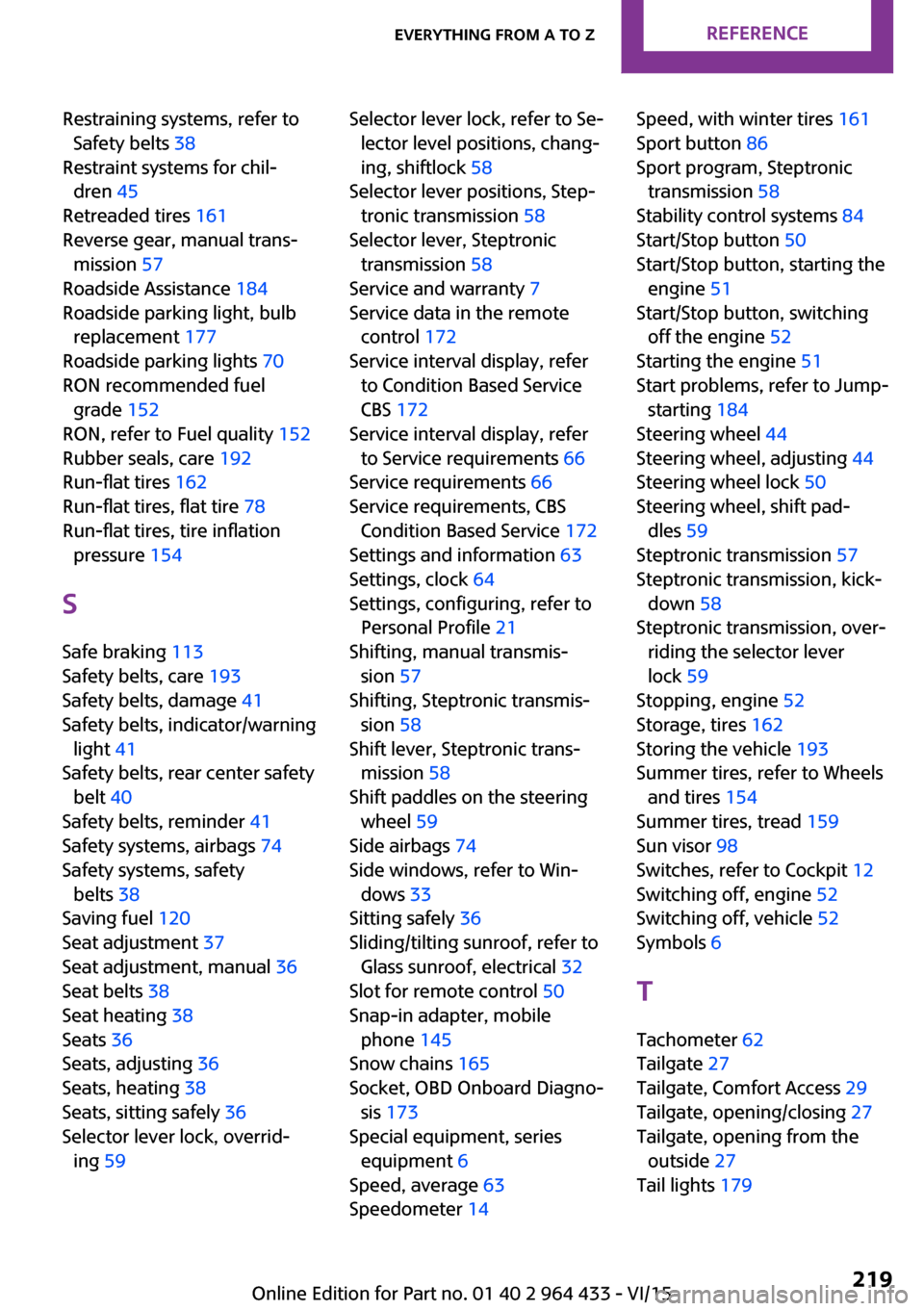
Restraining systems, refer toSafety belts 38
Restraint systems for chil‐ dren 45
Retreaded tires 161
Reverse gear, manual trans‐ mission 57
Roadside Assistance 184
Roadside parking light, bulb replacement 177
Roadside parking lights 70
RON recommended fuel grade 152
RON, refer to Fuel quality 152
Rubber seals, care 192
Run-flat tires 162
Run-flat tires, flat tire 78
Run-flat tires, tire inflation pressure 154
S
Safe braking 113
Safety belts, care 193
Safety belts, damage 41
Safety belts, indicator/warning light 41
Safety belts, rear center safety belt 40
Safety belts, reminder 41
Safety systems, airbags 74
Safety systems, safety belts 38
Saving fuel 120
Seat adjustment 37
Seat adjustment, manual 36
Seat belts 38
Seat heating 38
Seats 36
Seats, adjusting 36
Seats, heating 38
Seats, sitting safely 36
Selector lever lock, overrid‐ ing 59 Selector lever lock, refer to Se‐
lector level positions, chang‐
ing, shiftlock 58
Selector lever positions, Step‐ tronic transmission 58
Selector lever, Steptronic transmission 58
Service and warranty 7
Service data in the remote control 172
Service interval display, refer to Condition Based Service
CBS 172
Service interval display, refer to Service requirements 66
Service requirements 66
Service requirements, CBS Condition Based Service 172
Settings and information 63
Settings, clock 64
Settings, configuring, refer to Personal Profile 21
Shifting, manual transmis‐ sion 57
Shifting, Steptronic transmis‐ sion 58
Shift lever, Steptronic trans‐ mission 58
Shift paddles on the steering wheel 59
Side airbags 74
Side windows, refer to Win‐ dows 33
Sitting safely 36
Sliding/tilting sunroof, refer to Glass sunroof, electrical 32
Slot for remote control 50
Snap-in adapter, mobile phone 145
Snow chains 165
Socket, OBD Onboard Diagno‐ sis 173
Special equipment, series equipment 6
Speed, average 63
Speedometer 14 Speed, with winter tires 161
Sport button 86
Sport program, Steptronic transmission 58
Stability control systems 84
Start/Stop button 50
Start/Stop button, starting the engine 51
Start/Stop button, switching off the engine 52
Starting the engine 51
Start problems, refer to Jump- starting 184
Steering wheel 44
Steering wheel, adjusting 44
Steering wheel lock 50
Steering wheel, shift pad‐ dles 59
Steptronic transmission 57
Steptronic transmission, kick‐ down 58
Steptronic transmission, over‐ riding the selector lever
lock 59
Stopping, engine 52
Storage, tires 162
Storing the vehicle 193
Summer tires, refer to Wheels and tires 154
Summer tires, tread 159
Sun visor 98
Switches, refer to Cockpit 12
Switching off, engine 52
Switching off, vehicle 52
Symbols 6
T Tachometer 62
Tailgate 27
Tailgate, Comfort Access 29
Tailgate, opening/closing 27
Tailgate, opening from the outside 27
Tail lights 179 Seite 219Everything from A to ZREFERENCE219
Online Edition for Part no. 01 40 2 964 433 - VI/15